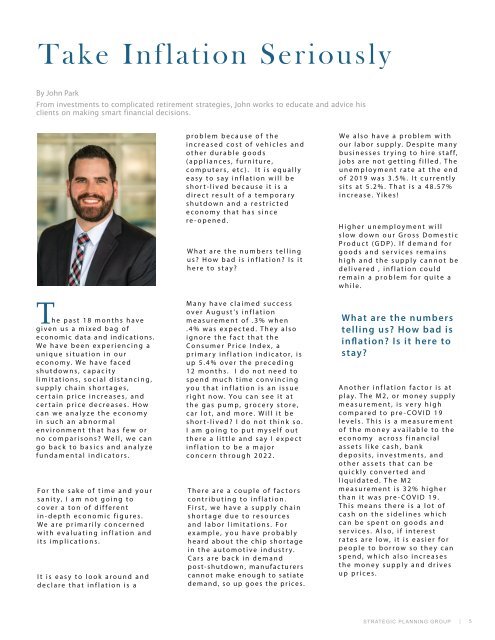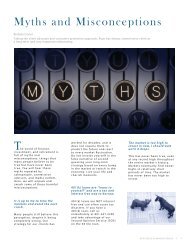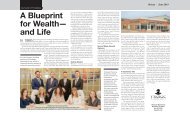Fall 2021 Newsletter
Strategic Planning Group's Fall 2021 Newsletter
Strategic Planning Group's Fall 2021 Newsletter
You also want an ePaper? Increase the reach of your titles
YUMPU automatically turns print PDFs into web optimized ePapers that Google loves.
Take Inflation Seriously<br />
By John Park<br />
From investments to complicated retirement strategies, John works to educate and advice his<br />
clients on making smart financial decisions.<br />
T.<br />
he past 18 months have<br />
given us a mixed bag of<br />
economic data and indications.<br />
We have been experiencing a<br />
unique situation in our<br />
economy. We have faced<br />
shutdowns, capacity<br />
limitations, social distancing,<br />
supply chain shortages,<br />
certain price increases, and<br />
certain price decreases. How<br />
can we analyze the economy<br />
in such an abnormal<br />
environment that has few or<br />
no comparisons? Well, we can<br />
go back to basics and analyze<br />
fundamental indicators.<br />
For the sake of time and your<br />
sanity, I am not going to<br />
cover a ton of different<br />
in-depth economic figures.<br />
We are primarily concerned<br />
with evaluating inflation and<br />
its implications.<br />
It is easy to look around and<br />
declare that inflation is a<br />
problem because of the<br />
increased cost of vehicles and<br />
other durable goods<br />
(appliances, furniture,<br />
computers, etc). It is equally<br />
easy to say inflation will be<br />
short-lived because it is a<br />
direct result of a temporary<br />
shutdown and a restricted<br />
economy that has since<br />
re-opened.<br />
What are the numbers telling<br />
us? How bad is inflation? Is it<br />
here to stay?<br />
Many have claimed success<br />
over August’s inflation<br />
measurement of .3% when<br />
.4% was expected. They also<br />
ignore the fact that the<br />
Consumer Price Index, a<br />
primary inflation indicator, is<br />
up 5.4% over the preceding<br />
12 months. I do not need to<br />
spend much time convincing<br />
you that inflation is an issue<br />
right now. You can see it at<br />
the gas pump, grocery store,<br />
car lot, and more. Will it be<br />
short-lived? I do not think so.<br />
I am going to put myself out<br />
there a little and say I expect<br />
inflation to be a major<br />
concern through 2022.<br />
There are a couple of factors<br />
contributing to inflation.<br />
First, we have a supply chain<br />
shortage due to resources<br />
and labor limitations. For<br />
example, you have probably<br />
heard about the chip shortage<br />
in the automotive industry.<br />
Cars are back in demand<br />
post-shutdown, manufacturers<br />
cannot make enough to satiate<br />
demand, so up goes the prices.<br />
We also have a problem with<br />
our labor supply. Despite many<br />
businesses trying to hire staff,<br />
jobs are not getting filled. The<br />
unemployment rate at the end<br />
of 2019 was 3.5%. It currently<br />
sits at 5.2%. That is a 48.57%<br />
increase. Yikes!<br />
Higher unemployment will<br />
slow down our Gross Domestic<br />
Product (GDP). If demand for<br />
goods and services remains<br />
high and the supply cannot be<br />
delivered , inflation could<br />
remain a problem for quite a<br />
while.<br />
What are the numbers<br />
telling us? How bad is<br />
inflation? Is it here to<br />
stay?<br />
Another inflation factor is at<br />
play. The M2, or money supply<br />
measurement, is very high<br />
compared to pre-COVID 19<br />
levels. This is a measurement<br />
of the money available to the<br />
economy across financial<br />
assets like cash, bank<br />
deposits, investments, and<br />
other assets that can be<br />
quickly converted and<br />
liquidated. The M2<br />
measurement is 32% higher<br />
than it was pre-COVID 19.<br />
This means there is a lot of<br />
cash on the sidelines which<br />
can be spent on goods and<br />
services. Also, if interest<br />
rates are low, it is easier for<br />
people to borrow so they can<br />
spend, which also increases<br />
the money supply and drives<br />
up prices.<br />
STRATEGIC PLANNING GROUP 5
















